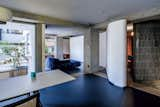6 more photos
Details
Credits
From YUKO NUMATA
In the very heart of Shibuya, stepping off the main avenue of Jingu and into a side street, the hum of cars and the bustling thoroughfare fade away. Landmarks disappear, and your sense of direction becomes unclear. At the same time, small shops and the lives of homes hidden behind towering trees reveal themselves.You notice the fruits of old garden trees and the vibrant colors of small birds. VillaSerena emerges just around the bend of such a narrow path. Painted in a yellow hue reflective of its half-century-old architecture, you ascend a few steps and find yourself, as if by chance, arriving at Room 204.
Room 204 is both a studio and home, shared by an architect and a casting director couple. For these two, whose work and personal lives often blur, it was essential to create a space that embraced this ambiguity while also allowing for moments of intense focus and immersion in their respective worlds.
The existing structure features exposed beams on both the ceiling and the floor, with thick 600mm columns forming a grid-like space. To highlight the beauty of this grid, the ceiling and floor were left bare, and the finished floor level was aligned
with the top surface of the floor beams. Within this grid and its irregular floor plan, a single curved wall was introduced to define activity area. This curved wall, intentionally offset from the rigidity of the grid, subtly connects spaces, manipulating the line of sight while maintaining a sense of continuity toward the depths of the space. Each area flows along the curve without corridors or doors, creating an organic sequence of spaces.
The kitchen and dining areas double as meeting spaces. The living area serves as a place to relax but can also transform into a screening room, as well as a whitebackdrop studio for photo shoot and filming. The study area features a 5.5-meter-long desk and a lowered floor, 320mm below the floor level, leveraging the reverse beam structure to minimize visual pressure toward the openings while creating a sunken, intimate space. The bedroom is partitioned with translucent curtains, allowing views of the window beyond the study area. The bathroom and closet are accessible from both the entrance and the bedroom side, forming a looped plan that permits movement without crossing paths with guests during visits. The openings are equipped with wind-catching windows that can be opened to align with the direction of the breeze, allowing airflow to permeate the entire room. Situated on a lower floor with high humidity, the design prioritizes comfort by ensuring air circulation even in areas such as the wet spaces and closets. The curved walls, with exposed beams on both the floor and ceiling, serve not only as architectural features but also as conduits for routing pipes and wiring through otherwise challenging spaces.
Openings are present on three outer walls, fostering a connection to the outdoors from every area of the room. The curved wall draws the eye toward these openings, where trees from the neighboring apartment or greenery on the terrace serve as
borrowed scenery. The curved wall reflects light from each opening, softly illuminating the entire space. In the early morning, sunlight reflecting off the building’s yellow exterior bathes the room in a warm, yellow glow.
The accent finishes use materials unique to Japan. For example, the tiles were originally created by applying and firing pine ash. The wooden parts are coated with kaki-shibu, a traditional Japanese persimmon tannin finish. The white curved wall is coated with plaster mixed with stone powder and then troweled to create a subdued, glowing texture.
Yellow fruit- and flower-bearing plants were selected to echo Villa Serena’s signature yellow. On the southern side, plantings were chosen to visually connect with the neighboring Castanopsis and Fatsia frees, using the same species for continuity.




















